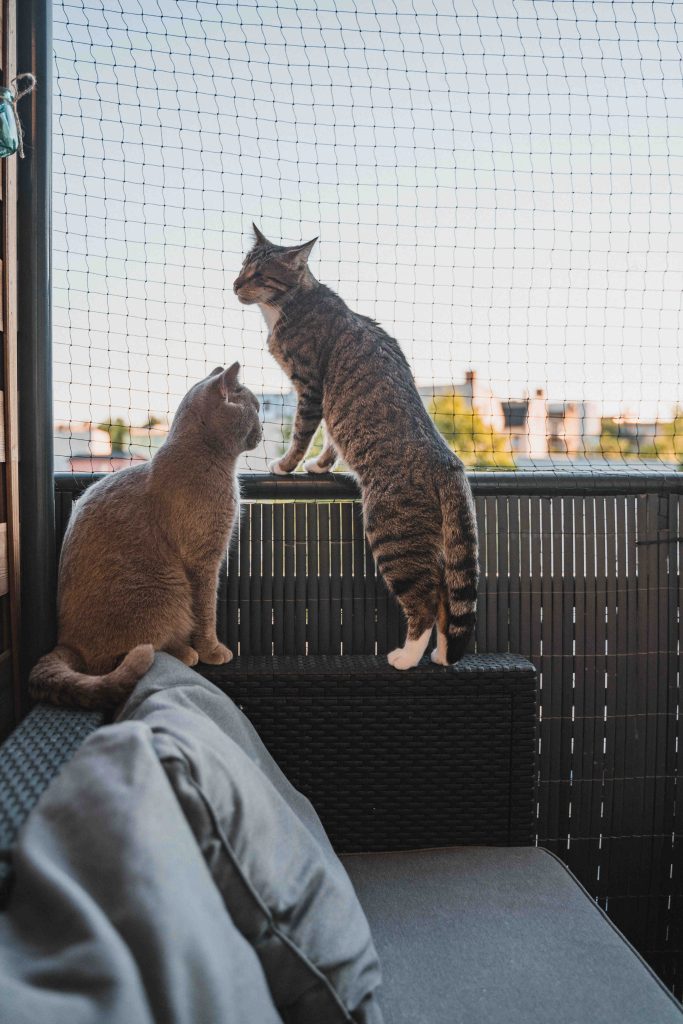Many cat owners live in (high-rise) buildings with balconies, and most felines love spending time out there, watching the world go by. As a cat owner, you might wonder if it’s safe to let your cat on the balcony and whether they might jump down. If you don’t have a balcony, don’t stop reading just yet, curious cats can still get into trouble around windows, which pose more dangers than just the risk of falling. Let’s take a closer look at the hazards balconies and windows present, and how we can keep our cats safe.
Do cats jump off balconies?
In short, yes, it happens. While cats naturally love high places, which might make you believe they’re always safe there, that’s not always the case. Most cats won’t intentionally jump off balconies or out of windows, but there are many situations where they might do so accidentally. Let’s look at a few common scenarios.
One possible scenario is when a cat loses balance while trying to catch or chase a bird on or near the balcony railing. Even cats that normally ignore the ledge often can’t resist the temptation when a bird is right there. Once their hunting instinct kicks in, one wrong move, or a slightly wet, slippery surface, can make them fall down. Unlike trees or wooden surfaces that provide grip, balconies offer little traction, making slips much more likely. Chasing prey on balconies can also lead to cats getting stuck in hard-to-reach spots, unable to climb back safely.
Another common scenario is when cats fall after being startled or frightened. Even the calmest cat can react suddenly to a loud noise or unexpected event. Fireworks, shouting, thunder, or any sudden sound can cause them to bolt or lose balance, leading to dangerous falls.
But don’t cats always land on their feet?
Cats have a remarkable reflex that helps them almost always land on their feet. Research shows that around 90% of cats who fall from balconies or windows and receive immediate veterinary care survive. However, those falling from greater heights often suffer a common set of injuries known as high-rise syndrome. It’s not unusual for these cats to sustain serious injuries such as ruptured organs, broken limbs, or shattered jaws, often requiring emergency treatment to survive and recover. Some cats may suffer injuries too severe to survive, while others could be left with lifelong effects such as partial paralysis. A few may walk away unharmed, but it’s simply not worth the risk.
A dangerous misconception is that falls from lower heights are safer, but that’s not true. Cats need time midair to twist their bodies and position their feet beneath them. Falls from lower levels don’t allow enough time for this reflex, increasing the risk of not landing on their feet, and, as a result, the risk of injury on impact.

Cats and Windows
Don’t have a balcony? Your cat can still get into trouble by jumping out of an open window. Besides the danger of falling, tilted windows pose another serious risk. Windows that open at the top can trap cats if they try to squeeze through. There have been cases where cats became stuck and couldn’t free themselves, sometimes with fatal consequences. Even if they manage to get loose, they can suffer severe injuries while trying to escape.
How can I safely let my cat on the balcony and cat-proof the windows?
Balconies can be made safer with specially designed cat safety nets. When choosing one, make sure it’s strong enough to withstand climbing and biting. Similar netting is also available for windows if you like keeping them open. Always check the nets for any holes or damage before letting your cat onto the balcony or opening a protected window. Make sure the netting is securely installed with no gaps or loose areas your cat could slip through. Keep in mind that most cats will be tempted to climb the net, so it must be durable, well-secured, and free from escape points, even at the top.
Conclusion
Letting your cat onto the balcony without safety measures is unsafe. While it may go well most of the time, it only takes one fall for your cat to be seriously injured, or worse. It’s simply not worth the risk, and as your cat’s guardian, it’s your responsibility to keep them safe. If you can’t make your balcony cat-proof, don’t allow your cat access to it. Also, be mindful of windows and secure them whenever necessary.
If you would like to know more about our cat sitting and cat relocation services, feel free to contact us. Our team will be happy to help.

